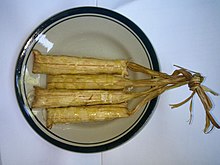 Kelupis in a
licuala grandis leaf wrapper. | |
| Type | Snack ( Kuih) |
|---|---|
| Place of origin | |
| Region or state | |
| Created by | Bruneian Malay , Lun Bawang/Lundayeh, Bisaya and Bajau [1] |
| Main ingredients | Glutinous rice flour, palm sugar |
Kelupis (which literally translates as 'glutinous rice rolls' in English) [2] is a traditional kuih for the Lun Bawang, Bruneian Malay people in the country of Brunei [3] and in the states of Sabah and Sarawak in Malaysia. [4] [5] It is also a traditional snack for the Bisaya people, while for the Lun Bawang/Lundayeh people, the confection is made in large batches especially during a traditional wedding ceremony. [1]
See also
References
- ^ a b "Rice in Many Forms (Kelupis)". New Sabah Times. p. 6. Archived from the original on 9 May 2015. Retrieved 12 October 2014.
- ^ Tamara Thiessen (2012). Borneo: Sabah - Brunei - Sarawak. Bradt Travel Guides. pp. 145–. ISBN 978-1-84162-390-0. Retrieved 17 August 2013.
- ^ Abd. Latip Talib (2006). Beraraklah awan pilu (in Malay). Utusan Publications. pp. 127–. ISBN 978-967-61-1899-8. Retrieved 17 August 2013.
- ^ "Kebudayaan (Brunei)" (in Malay). Papar District Office. Archived from the original on 26 October 2004. Retrieved 17 August 2013.
- ^ "An encounter with 'Kuih Kelupis'". Borneo Post Online. 13 March 2011. Retrieved 17 August 2013.
 Kelupis in a
licuala grandis leaf wrapper. | |
| Type | Snack ( Kuih) |
|---|---|
| Place of origin | |
| Region or state | |
| Created by | Bruneian Malay , Lun Bawang/Lundayeh, Bisaya and Bajau [1] |
| Main ingredients | Glutinous rice flour, palm sugar |
Kelupis (which literally translates as 'glutinous rice rolls' in English) [2] is a traditional kuih for the Lun Bawang, Bruneian Malay people in the country of Brunei [3] and in the states of Sabah and Sarawak in Malaysia. [4] [5] It is also a traditional snack for the Bisaya people, while for the Lun Bawang/Lundayeh people, the confection is made in large batches especially during a traditional wedding ceremony. [1]
See also
References
- ^ a b "Rice in Many Forms (Kelupis)". New Sabah Times. p. 6. Archived from the original on 9 May 2015. Retrieved 12 October 2014.
- ^ Tamara Thiessen (2012). Borneo: Sabah - Brunei - Sarawak. Bradt Travel Guides. pp. 145–. ISBN 978-1-84162-390-0. Retrieved 17 August 2013.
- ^ Abd. Latip Talib (2006). Beraraklah awan pilu (in Malay). Utusan Publications. pp. 127–. ISBN 978-967-61-1899-8. Retrieved 17 August 2013.
- ^ "Kebudayaan (Brunei)" (in Malay). Papar District Office. Archived from the original on 26 October 2004. Retrieved 17 August 2013.
- ^ "An encounter with 'Kuih Kelupis'". Borneo Post Online. 13 March 2011. Retrieved 17 August 2013.